1. INTRODUCTION
All living organisms have an instinct to live their own lives and then survive through their generations. Living things take birth, grow old and die. Before death individuals give birth to the off springs (children) to continue their race. Have you ever provoked you mind to know the process that leads to off springs? The answer is right here . . .This survival instinct is helped by the process of Reproduction.
Giving birth to off springs, which are similar to parents, is known as reproduction.
Importance of Reproduction
Reproduction is one of the most important characteristics of life. Reproduction is the creation of new life of its own kind. Reproduction is essential for the continuation of species. A species will disappear from the face of the earth if it does not reproduce. Reproduction takes place in both, plants and animals.
2. ASEXUAL REPRODUCTION
When a single parent is involved in the process, it is called asexual reproduction. Following means of asexual reproduction are used by plants:
3. BUDDING
This method is used by unicellular plants; like yeast. Yeast is a fungus and fungi are also known as non-green plants. The yeast cell produces a bud which gets its own nucleus. The bud develops to certain size and detaches from the mother cell to produce the new yeast.
Budding in yeast
Yeast is tiny, unicellular, non-green plant (which is a fungus). Yeast reproduces by budding. The Figure below shows a parent yeast cell (which is a complete plant). In yeast, first a bud appears on the outside of the cell wall.

The nucleus of parent yeast cell then divides into two parts and one part of the nucleus moves into the bud. Ultimately, the bud separates off from the parent yeast cell and forms a new yeast cell (or new yeast plant). The budding in yeast, however, often takes place so fast that the first buds start forming their own buds and all of them remain attached to the parent yeast 11 forming a chain of yeast cells. After some time, all the yeast cells of the chain separate torn one another and form individual yeast plants.
Noteworthy Points
Note the formation of buds on the yeast cells and how they separate from the parent cell. In some organisms like sponges and corals, the buds remain attached to the parent organism permanently. These buds then grow and produce buds of their own. In this way, a colony of sponges or corals is formed.
4. FRAGMENTATION
The breaking up of the body of a simpler multicellular organism into two or more pieces on maturing, each of which subsequently grows to form a complete new organism is called fragmentation.
Examples: Spirogyra and sea anemones reproduces by fragmentation.
Fragmentation In Spirogyra
Spirogyra is a green, filamentous alga plant which is found in ponds, lakes and slow moving streams. Spirogyra filament simply breaks into two or more fragments on maturation, and each fragment then grows into a new Spirogyra.

This breakup of the filament of a mature Spirogyra on its own brings about asexual reproduction. Thus, Spirogyra reproduces by the asexual method of fragmentation.
Note:
A mature spirogyra produces three new spirogyra. Both fission and fragmentation are asexual and in both splitting take place. Then why not they are same or what is the difference between them?
In fission, a unicellular organism breaks up to form two (or more) daughter organisms, whereas in fragmentation, a multicellular organism breaks up to form two (or more) daughter organisms.
5. SPORE FORMATION
Spore formation is the asexual method of reproduction. The reproduction by spore formation takes place in plants. In spore formation, the parent plant produces hundreds of microscopic reproductive units called ‘spores’. When the spore case of the plant bursts, then the spores spread into air. When these air-borne spores land on food under favourable conditions, they germinate and produce new plants.
Examples.

The tiny spores of bread mold (a fungus plant) are almost always present in the air. If we keep a moist slice of bread aside for a few days, then the spores of bread mold plant present in air settle on the moist bread and germinate to form new fungus plants. The bread mold plants first look like a white cottony mass covering the bread slice which later on turns black. If we observe the surface of this slice of bread through a magnifying glass, then the bread mold plant growing on it will appear to be like that shown.
Spore Formation InRhizopus
- The common bread mold plant consists of fine, threadlike projections called hyphae and thin stems having knob- like structures called sporangia.
- Each knob- like structure (or sporangium) contains hundreds of minute spores enclosed in a spore case. When the spore case bursts, the tiny spores are dispersed in air.
- These spores are the asexual reproductive units which can produce more bread mold plants under suitable conditions.
- These spores are the asexual reproductive units which can produce more bread mold plants under suitable conditions.
- If we remove one sporangium from the bread mold, keep it on a slide, put a cover slip over it and observe this slide through a microscope, we can see the spores.

6. VEGETATIVE PROPAGATION
In vegetative propagation, new plants are obtained from the parts of old plants (like stems, roots and leaves), without the help of any reproductive organs.
- Vegetative propagation is an asexual method of reproduction.
- The reproduction by vegetative propagation occurs only in plants.
- Vegetative propagation usually involves the growth and development of one (or more) buds present on the old part of the plant to form a new plant.
- These buds are in the dormant state (inactive state) in the old part of the plant.
- When provided suitable conditions (like moisture, warmth, etc.), these buds grow to form new plants.
- Please note that vegetative propagation is also called vegetative reproduction.
(A) Vegetative Propagation In Grass
It is a common observation that green grass plants spring up in dry fields after the rains. This happens due to vegetative propagation as follows :

- The fields have dry stems of the old grass plants all over them.
- These dry stems have buds which are in the inactive state.
- By getting rain water, the buds present on dry grass stems get activated and grow to produce new grass plants.
- Thus, the green grass grows in the fields after rains from the dry, old stems of grass plants present in the fields, by the method of vegetative propagation.
(B) Vegetative Propagation In Bryophyllum
- Buds are present on the stems as well as the leaves of the Bryophyllum plant which can develop into new plants.
- Bryophyllum plants can be reproduced by vegetative propagation by using either a piece of its stem or its leaves.
- If a broken piece of the stem of a Bryophyllum plant in the ground, we will get a new Bryophyllum plant growing from it in a week’s time.

- Even the leaves of a Bryophyllum plant can produce new plants.
- The leaves of a Bryophyllum plant have special type of buds in their margins (or edges).
- These buds may get detached from the leaves, fall to the ground and then grow to produce new Bryophyllum plants.
- The buds can also drop to the ground together with the leaf and then grow to produce new plants.
- Sometimes even before a leaf drops off from a Bryophyllum plant, we can see new plantlets already growing on it.
- When such a mature leaf of the Bryophyllum plant falls on the ground, then each plantlet can grow into a new plant.
- Thus, the leaves of Bryophyllum plant can produce new plants.
- Another plant called Begonia also reproduces by vegetative propagation through its leaves.
(C) Vegetative Propagation In Money Plant
- Cut a piece of stem of money plant in such a way that it contains at least one leaf on it
Note: The point on stem where a leaf is attached is called a node. - Dip one end of this stem in water.
- After a few days we will find that new roots appear at the point where leaf was attached.
- The piece of stem will gradually grow into a new money plant.
Note
If we cut the stem of money plant in between two leaves, then it will not grow into a new plant. This is because it does not have a growing point (here a node) in it
(D) Vegetative Propagation In Tubers
- A tuber is the thickened, underground stem (or root) of a plant which is swollen with stored food.
- The tuber has a number of ‘buds’ (called ‘eyes’).
- Each bud of the tuber grows into a new plant when the old tuber is planted in the soil in the next growing season.
- There are two types of tubers: stem tubers and root tubers.
- Potato is a stem tuber whereas sweet potato is a root tuber.

- Potato tuber is an underground stem of the potato plant.
- Each potato tuber can produce more than one plant.
- A potato tuber has many buds (called eyes) on its body.
- When a potato tuber is planted in the soil, then the various buds of the potato tuber start growing to form new potato plants.
(E) Vegetative Propagation In Guava Plant
- The roots of a guava plant have buds which can develop into new guava plants.
- In fact, a large number of plants can be reproduced by the method of vegetative propagation.
Other examples
Potato, Onion, Banana, Garlic, Water hyacinth, Tulip, Mint, Strawberry and Lily.
7. SEXUAL REPRODUCTION IN PLANTS
When two parents are involved in the process, it is called sexual reproduction. Two gametes, viz. male and female gametes, are formed. The fusion of male and female gametes is called fertilization. Zygote is formed after fertilization. The zygote develops into an embryo and finally into a new individual.
Flower is the main reproductive organ of a plant.
8. STRUCTURE OF A FLOWER
A flower represents the reproductive part of a plant body. It is, the most important part meant for multiplication of the species.
Often, each flower has a stalk called the pedicel. But some flowers do lack the pedicel, and such flowers are called sessile. Besides the stalk, a flower, in general, shows four sets of whorls or parts arranged in rings or whorls
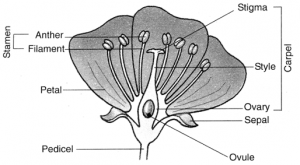
1. Calyx is the outermost whorl or set composed of green, leaf-like protective structures called sepals.
2. Corolla is the next inner whorl composed of brightly coloured petals. Being brightly coloured, petals attract insects for pollination.
3. Androecium: The third whorl is called androecium. It is composed of stamens. Stamen has two main parts. The tube-like portion is called filament. The capsule like structure at the top is called anther. The anther produces pollen grains; which are the male gametes
4. Gynoecium: The whorl at the center is called gynoecium. It has a swollen base; called ovary and a tube-like structure; called style. The top of the tube is somewhat flattened and is called stigma. Ovary produces the eggs or female gametes. Ovules and ovary finally develop into seeds and fruits respectively.
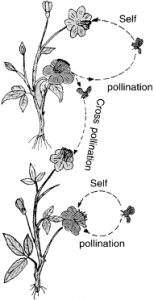
9. POLLINATION
Pollination is the transfer of pollen grains from the ripe anther to the stigma. The transfer of pollen grains to the stigma can take place in two ways:
(i) Within the same flower or between flowers of the same plant.
(OR)
(ii) Between flowers from different plants of the same species.
Pollination in the first case is called self-pollination, while it is called cross-pollination in the second case(Figure.).
Cross-pollination often involves various external agencies to carry pollen grains from one flower to another one. These agencies may be air, water, or insects. Most flowers are pollinated by insects.
Pollen grains of all flowers are not carried by insects. In some cases, they are carried by wind (wind pollination). In the case of water plants, pollen grains are carried by water (water pollination).
| Difference between Insect-pollinated and Wind-pollinated flowers | |
| Insect-pollinated flowers | Wind-pollinated flowers |
| 1. Large and brightly-coloured 2. Nectar and scent is produced. 3. Pollen grains are sticky. 4. Pollen grains are produced in less quantity. |
1. Small and inconspicuous. 2. No nectar or scent is produced. 3. Pollen grains are dry. 4. Pollen grains are produced in large quantity. |
10. FERTILIZATION
Fertilization is a step between pollination and seed formation. The fusion of the male gamete with the female gamete is called fertilization.
During fertilization, the following events take place:
1. The pollen grains germinate on the stigma, and pollen tubes develop.
2. The pollen tubes move downwards into the style (Figure).
3. The pollen tubes are the carriers of male gametes.
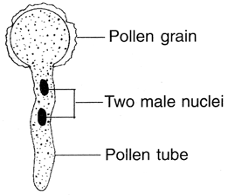
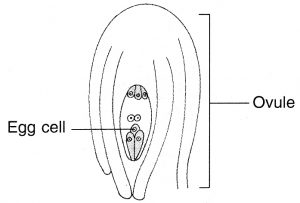
Female gamete (egg cell) inside the ovule
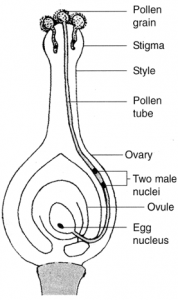
4. One pollen tube finally enters the ovule, where female gamete (egg) is located (figure) Female gamete or egg cell is present inside the ovule.
5. Finally the male gamete fuses with the female gamete. This completes the process of fertilization.
11. FORMATION OF FRUIT AND SEED
(A) Formation Of Fruit and Seed
1. The flower loses its bright colour.
2. The sepals, petals and stamens fall off.
3. The ovary increases in size and becomes the fruit.
4. The ovary wall becomes the fruit wall.
5. Inside the ovary, the ovules develop to form the seeds.
(B) Types of Fruits
(i)Dry fruit: Fruits of the type of pea are called dry fruits. The fruit wall in such fruit is thin and dry.
Examples: Cotton, lady’s finger, maize, sunflower, bean.
(ii)Fleshy fruit: On the other hand, mango fruit is a fleshy fruit, as the fruit wall is thick and fleshy.
Examples: Tomato, brinjal, orange, coconut, plum.
(C) Functions of Fruits
(i) The fruit wall gives protection to the seeds and therefore to the embryo.
(ii) The fruit is a store house of food material.
(iii) The fruit helps in dispersal of seeds.
(D) Seed
A seed contains an embryo, one or two cotyledons and a protective seed coat (Figure). The embryo, after germination of the seed, develops into a new plant. The cotyledons often contain reserve food material for the developing plant.

(E) Structure Of A Fruit
A fruit is a ripened ovary formed after fertilization. A fruit, consists of two parts
(i) The fruit wall (or pericarp), and
(ii) Seeds.
(F) Fruit Wall
The fruit wall develops from the wall of the ovary. It may be thick or thin. It may be dry as in pea or gram (Figure.) or fleshy as in tomato (Figure) and papaya. In fruits like mango, the pericarp may be differentiated into three layers (Figure):
The fruit wall has three layers:
1. the outer layer called the epicarp,
2. the middle layer called the mesocarp, and
3. the inner layer called the endocarp.
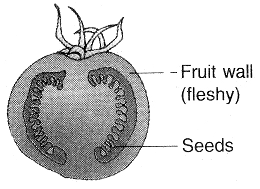
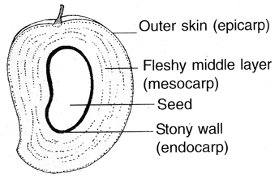
Parts of a fruit (mango)
(G) Seeds
Seeds which develop from the ovules are present inside the fruit wall. A fruit may contain only one seed (as in mango, plum) or many seeds, as in the case in tomato, orange, apple.
Fruits of the type of pea are called dry fruits. The fruit wall in such a fruit is thin and dry.
On the other hand, mango fruit is a fleshy fruit, as the fruit wall is thick and fleshy
(H) Functions of a Fruit
1. It protects the seeds from animals and unfavourable climatic conditions.
2. It helps in dispersal of seeds to distant places by means of various devices which the fruits often develop.
(I) The Seed
A seed contains a baby plant inside. It also contains food for the new plant to develop. More precisely, the seed consists of an embryo, one or two cotyledons and a protective seed coat. Embryo is represented by plumule and radicle (Figure). The cotyledons often contain the reserve food material for the developing plant. On germination, plumule gives rise to the shoot system while radicle gives rise to the root system (Figure) and thus, develops a new plant.
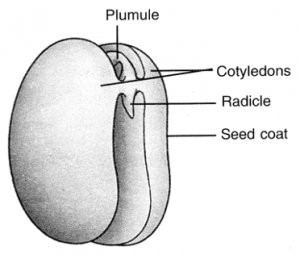
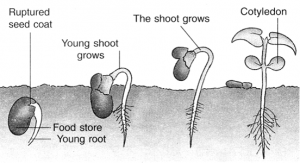
Seed Germination
12. Dispersal Of Seeds And Fruits
Plant do not move. The seeds and fruits produced by them have developed devices which help them to be carried to faraway places. This prevents overcrowding at one place and also leads to the spread of plants to newer places. There are three main types of dispersal mechanism:
(i) By Wind (ii) By Water (iii) By Animals
(A) Dispersal By Wind
Examine the seeds of dandelion, Calotropis (madar), Acer (maple), cotton and pine.
Seeds of dandelion (Figure) and cotton possess a tuft of fine hair, while in Acer and pine (Figure), the fruits/seeds develop flat, wing-like structures.

The hair or the wings help in the dispersal of seeds and fruits to long distances by wind.
(B) Dispersal By Water
Coconut plants are grown on the sea shore. The fibrous fruit falls in water and is carried away from the parent plant by water currents. In lotus, the fruit floats on the surface of water and the seeds are liberated in water. Water currents carry the seeds to long distances.
(C) Dispersal By Animals
Seeds and fruits dispersed by animals are either edible or develop hooks and thorns. Seeds of fruits like mango, orange and plum get dispersed after the fleshy part of these fruits is eaten by humans and birds.

Fruit of Xanthium with spines
Fruits of gokhru (Tribulus) and okra (Xanthium) possess hooks and spines (Figure.). These fruits stick to our clothes and to the body of passing animals, and then get carried away from one place to another.
This, plants have developed various means to get their seeds and fruits carried away to long distances.
Dispersal by Bursting: Some fruits burst open when they mature. The force of bursting is enough to spread the seeds. Examples; Ladyfinger, castor, balsam, etc.
Dispersal by Humans: Human beings also help in dispersal of seeds, especially during farming.








